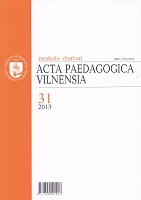Studentų kūrybiškumo, asmenybės bruožų ir gimimo eiliškumo sąsajos
STUDENTS’ CREATIVITY, PERSONALITY TRAITS, AND BIRTH ORDER
Author(s): Daiva Grakauskaitė-KarkockienėSubject(s): Education
Published by: Vilniaus Universiteto Leidykla
Keywords: creativity; personality traits; birth order; art and social science students
Summary/Abstract: The aim of this study was to investigate the relationship between creativity, personality traits, and birth order among students. The subjects included social science and art students (n = 101, age 22 years of the) from Lithuanian Educological University. Students of social science (N = 48) and of art (dance, art, music, and theatre) have been investigated. Creativity was evaluated employing the E.E. Tunik questionnaire. It was used to estimate such characteristics of creativity as tendency to risk, imagination, curiosity, and complexity. Personality traits were assessed using the Big Five questionnaire (by O. D. John). The questionnaire consists of 44 propositions and has five subscales: extraversion, agreeableness, conscientiousness, neuroticism, and openness. The students were also asked about their birth order in their own family as well as how many children there were grown in the family. The aim of the study was to explore the relationship between students’ creativity, personality traits, and birth order. It was revealed that art students were slightly more creative than social science students. However, the difference was not statistically significant. The results also showed a positive relationship between creativity and openness (r = 0.416, p = 0.000). There were no other statistically significant correlations between creativity and other personal traits. The youngest children in the family were more extravert than the elder ones (p = 0.045). There was no significant difference between creativity and birth order.
Journal: Acta Paedagogica Vilnensia
- Issue Year: 2013
- Issue No: 31
- Page Range: 84-94
- Page Count: 11
- Language: Lithuanian

